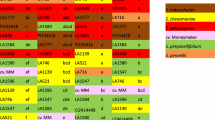Abstract
Insect-resistant and -susceptible geranium plants (Pelargonium xhortorum) were chemically and morphologically compared to assess the relative importance of resistance components. Glandular and nonglandular trichome density and quantification of trichome exudate (anacardic acids) from inbred resistant and susceptible lines were determined. Three different extraction procedures were employed to quantify the anacardic acids: (1) capillary solvent extract, (2) leaf wipe, and (3) whole leaf extract. The results support the conclusion that tall glandular trichomes and the exudate they produce are the most important factors in small pest resistance in the geranium. In addition, it was shown that tall glandular trichome densities are less and the ability of the plant to express the anacardic acids as exudate on the trichome head exterior is lacking in the susceptible lines analyzed, even though all lines possessed the capability to synthesize the anacardic acids. A plant line of intermediate resistance character was shown to possess high densities of tall glandular trichomes but resembled susceptible plants in lacking the ability to express the anacardic acids as an exudate in appreciable quantities.
Similar content being viewed by others
References
Chang, K.P., Snetsinger, R., andCraig, R. 1972. Leaf characteristics of spider mite resistant and susceptible cultivars ofPelargonium xhortorum.Entomol. News 83:191–197.
Craig, R., Mumma, R.O., Gerhold, D.L., Winner, B.L., andSnetsinger, R. 1986. Genetic control of a biochemical mechanism for mite resistance in geraniums, pp. 168–176,in M.B. Green and P.A. Hedin (ed.). Natural Resistance of Plants to Pests. Symposium Series 296. American Chemical Society, Washington, D.C.
Gerhold, D.L., Craig, R., andMumma, R.O. 1984. Analysis of trichome exudate from mite resistant geraniums.J. Chem. Ecol. 10:713–722.
MacDonald, A.J., Root, J., Snetsinger, R., andCraig, R. 1971. Techniques for evaluating host resistance to the two-spotted spider mite,Tetranychus urticae.Melsheimer Entomol. 8:1–4.
Sokal, R.R., andRohlf, F.J. 1969. Biometry. W.H. Freeman, San Francisco.
Stark, R.S. 1975. Morphological and biochemical factors relating to spider mite resistance in the geranium. PhD thesis. Pennsylvania State University, University Park, Pennsylvania.
Walters, D.W., Minard, R., Craig, R., andMumma, R.O. 1988. Structural determination and biosynthetic considerations of the anacardic acids in geranium.J. Chem. Ecol. 14:743–751.
Winner, B.L. 1975. Inheritance of resistance to the two-spotted spider mite,Tetranychus urticae (Koch) in the geraniumPelargonium Xhortorum (Bailey). MS thesis. Pennsylvania State University, University Park, Pennsylvania.
Author information
Authors and Affiliations
Rights and permissions
About this article
Cite this article
Walters, D.S., Grossman, H., Craig, R. et al. Geranium defensive agents. IV. Chemical and morphological bases of resistance. J Chem Ecol 15, 357–372 (1989). https://doi.org/10.1007/BF02027796
Received:
Accepted:
Issue Date:
DOI: https://doi.org/10.1007/BF02027796




